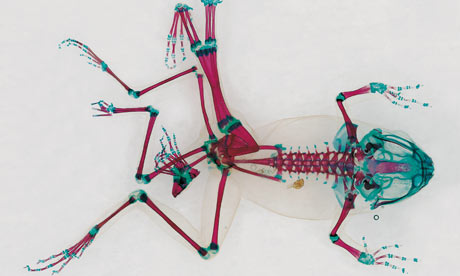TOP STORIES Outbreak kills hundreds of bighorn sheep in West
Outbreak kills hundreds of bighorn sheep in West
Pneumonia outbreaks that have killed hundreds of wild bighorn sheep this winter in several Western states have wildlife officials grappling with how to minimize the impact.
The disease shows up sporadically in wild herds, but it's unusual to have so many outbreaks in so many states, wildlife officials said Friday.
More than 400 bighorn sheep in Nevada, Montana, Utah and Washington have died or been killed by wildlife officials this winter, and the death toll is expected to rise in coming weeks.
>>>FULL ARTICLE
Seattle PI - www.seattlepi.com (Source: Associated Press)
26 Feb 2010
M Griffith
Photo credit: www.nrmsc.usgs.gov
Seattle PI - www.seattlepi.com (Source: Associated Press)
26 Feb 2010
M Griffith
Photo credit: www.nrmsc.usgs.gov
Mountaintop Mining Poisons Fish
Dead and deformed fish indicate selenium pollution from mountaintop coal mining is causing permanent damage to the environment and poses serious health risks, says a Wake Forest University biologist who will brief U.S. Senators on his research Feb. 23.
Selenium pollution affects fish first, so they are the best barometer for understanding the threat to ecosystems downstream from mountaintop removal mining operations, says Dennis Lemly, research professor of biology, who advocates a ban on the process.
"We're killing fish right now with selenium pollution from mountaintop removal mining," says Lemly. Toxic levels of selenium were found in 73 of 78 stream samples.
 More bats infected with deadly disease found in WV cave
More bats infected with deadly disease found in WV cave. . . “We’ve had a constant stream of bats just flying out of the cave during the day, during snow, so they’re obviously very distressed and fleeing the site,” he added.
Stihler says the disease was probably initially transmitted to West Virginia bats by a caver. It’s believed that the disease can live on cavers’ equipment. But Stihler thinks the bats have spread it to other caves in the state.
“Last year we were estimating we had maybe 200 to 300 bats that have died. When we were at Hellhole this year we were seeing a stream of up to 40 bats an hour just leaving the cave, flying out. I’m sure most of those bats just died on the landscape,” said Stihler.
>>>FULL ARTICLE 
West Virginia Public Broadcasting - www.wvpubcast.org
28 Feb 2010
E Corio
Photo credit: Marvin Moriarty/USFWS
West Virginia Public Broadcasting - www.wvpubcast.org
28 Feb 2010
E Corio
Photo credit: Marvin Moriarty/USFWS
An ailing pygmy sperm whale beached itself and died Sunday morning at Jetty Park, attracting wildlife biologists and roughly 100 spectators.
The whale was a mature male measuring 11 feet and weighing more than 1,000 pounds, said Teresa Mazza, a Hubbs-SeaWorld Research Institute biologist.
Authorities received reports of a beached whale about 7 a.m. a couple hundred yards south of the Jetty Park pier, said Eisen Witcher, Brevard County Ocean Rescue assistant chief. The marine mammal died shortly afterward, Mazza said.
>>>FULL ARTICLE 
Florida Today - www.floridatoday.com
01 Mar 2010
R Neale
Photo credit: Malcolm Denemark, Florida Today
Location - Brevard County, Florida, USA - Map It

Florida Today - www.floridatoday.com
01 Mar 2010
R Neale
Photo credit: Malcolm Denemark, Florida Today
Location - Brevard County, Florida, USA - Map It

OTHER WILDLIFE HEALTH RELATED NEWS
Photo credit: Brandon Ballengée
 Body of Evidence [new book of eye-catching work by artists blurring the boundaries between art and science]
Body of Evidence [new book of eye-catching work by artists blurring the boundaries between art and science]- OIE receives a Canadian $2 million contribution from Canada for animal health activities
- City plans raccoon vaccination for local parks [New York City]
- Kenya, Tanzania in joint wildlife census
- Threat to Monkey Numbers from Forest Decline
- Japan's giant salamander population decreasing
- Butterfly Vision, Wing Colors Linked
- Tree-Dwelling Mammals Climb to the Heights of Longevity
- Beewolves Protect Their Offspring With Antibiotics; Digger Wasp Larvae Use Bacteria Against Infections
- U.K. zoo builds a "love shack" for critically endangered frogs
WILDLIFE HEALTH RELATED PUBLICATIONS
Browse complete Digest publication library here.
 Emerging Infectious Diseases - March 2010
Emerging Infectious Diseases - March 2010Volume 16, Number 3
Chronic Wasting Disease - Update Report #96 - 26 February 2010 [pdf]
USGS National Wildlife Health Center/ B Richards
Pathogens in vertebrate pests in Australia [2009 report] [pdf]
Invasive Animals Cooperative Research Centre/ WR Henderson
Annual Report on Surveillance for Avian Influenza in Wild Birds in the EU in 2008 [report] [pdf]
Prepared by: Community Reference Laboratory for Avian Influenza and Veterinary
Laboratory Agency (VLA)
Reassortment between avian H5N1 and human H3N2 influenza viruses creates hybrid viruses with substantial virulence
Proc Natl Acad Sci U S A. 2010 Feb 22. [Epub ahead of print]
C Li et al.
Experimental oral transmission of chronic wasting disease to red deer (Cervus elaphus elaphus): Early detection and late stage distribution of protease-resistant prion protein
Can Vet J. 2010;51:169–178 [search publisher site for abstract]
A Balachandran et al.
Update on White-Nose Syndrome: Tennessee Finding - Wildlife Health Bulletin 2010-01 - 19 Feb 2010
USGS National Wildlife Health Center




